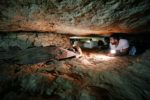 Archaeologists have discovered a previously unknown necropolis from the late pharaonic and early Ptolemaic periods in Minya, 150 miles south of Cairo. Burial grounds have been found in the area before. Late last year, archaeologists embarked on an excavation with the aim of discovering the rest of the necropoli at Minya, and soon struck paydirt. They unearthed tombs of priests of Thoth, inventor of writing, god of wisdom and the patron deity of the 15th nome (province) of Upper Egypt, known as Khmno, and of its capital city Ashmounin. They also found burials of the priests’ family members.
Archaeologists have discovered a previously unknown necropolis from the late pharaonic and early Ptolemaic periods in Minya, 150 miles south of Cairo. Burial grounds have been found in the area before. Late last year, archaeologists embarked on an excavation with the aim of discovering the rest of the necropoli at Minya, and soon struck paydirt. They unearthed tombs of priests of Thoth, inventor of writing, god of wisdom and the patron deity of the 15th nome (province) of Upper Egypt, known as Khmno, and of its capital city Ashmounin. They also found burials of the priests’ family members.
 One of the tombs belonged to a priest identified in the hieroglyphics on his canopic jars as Djehuty-Irdy-Es, a Haras Sa Aissa, meaning one of the Great Five, a title reserved the senior priests of Thoth. The four alabaster canopic jars, all in excellent condition, still contain the remains of the deceased’s mummified organs. Their lids represent the heads of the sons of Horus. The priest’s mummy was found wearing a gilded bronze collar depicting the winged sky goddess Nut.
One of the tombs belonged to a priest identified in the hieroglyphics on his canopic jars as Djehuty-Irdy-Es, a Haras Sa Aissa, meaning one of the Great Five, a title reserved the senior priests of Thoth. The four alabaster canopic jars, all in excellent condition, still contain the remains of the deceased’s mummified organs. Their lids represent the heads of the sons of Horus. The priest’s mummy was found wearing a gilded bronze collar depicting the winged sky goddess Nut.
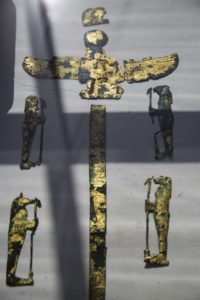 Mostafa Waziri, secretary general of the Supreme Council of Antiquities (SCA) and leader of the excavation describes the mummy thus:
Mostafa Waziri, secretary general of the Supreme Council of Antiquities (SCA) and leader of the excavation describes the mummy thus:
The mummy is decorated having a collection of blue and red beads as well as bronze gilded sheets, two eyes carved in bronze and ornamented with ivory and crystal beads.
“It is seen stretching her wings to protect the deceased, according to an ancient Egyptian belief,” Waziri said, adding that four amulets of semi-precious stones were also found decorated with engraved hieroglyphic texts, one phrase says, “Happy New Year.”
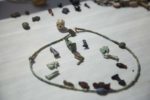 That amulet, a scarab, was discovered on New Year’s Eve in what is either a fortuitous coincidence or a sign that the ancient gods aren’t quite dead yet. The mummy is in a relatively good state of preservation but has suffered some moisture damage.
That amulet, a scarab, was discovered on New Year’s Eve in what is either a fortuitous coincidence or a sign that the ancient gods aren’t quite dead yet. The mummy is in a relatively good state of preservation but has suffered some moisture damage.
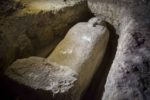 A large group of people, likely the priest’s family, was buried close by. The sarcophagi of 40 family members were found in the tombs. These are very high quality, expensive limestone coffins, many of them anthropoid and engraved with hieroglyphics that include the owners’ names.
A large group of people, likely the priest’s family, was buried close by. The sarcophagi of 40 family members were found in the tombs. These are very high quality, expensive limestone coffins, many of them anthropoid and engraved with hieroglyphics that include the owners’ names.
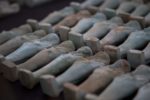 All told, so far the team has explored 13 burials. In these other tombs archaeologists have found more sarcophagi, statuettes, pottery and other funerary artifacts, including more than a thousand intact faience ushapti figurines plus hundreds more broken into pieces and the excavation is far from over. According to Antiquities Minister Khaled al-Anani, the density of finds is so significant that it will take at least five years to fully excavate the necropolis.
All told, so far the team has explored 13 burials. In these other tombs archaeologists have found more sarcophagi, statuettes, pottery and other funerary artifacts, including more than a thousand intact faience ushapti figurines plus hundreds more broken into pieces and the excavation is far from over. According to Antiquities Minister Khaled al-Anani, the density of finds is so significant that it will take at least five years to fully excavate the necropolis.
I have always wondered about family burials. When the priest died, was he buried first, and the rest of his family followed after their natural lifetime? or was it a one-time burial, that is, all the family decided to be interred at the same time, regardless of health or age? I suppose if you survived, your status would change perhaps drastically, as the living priest secured his family’s social position. Has this question been researched?
Well, since belonging to the priesthood often ran in families I guess that the other family members were buried in due time, otherwise it would make for very very short family careers.
This is the only part of the article that gives the reader any idea of from when these items come:
the late pharaonic and early Ptolemaic periods in Minya in Minya
I have spent time exploring Egypt several times and have published books with chapters of photographs from Egypt. I have worked on archaeological sites in the Middle East many times over the years. Still, even for me “the late pharaonic and early Ptolemaic periods” is an awfully vague time period. I just think one should at least give some dates on any history article for the general public.